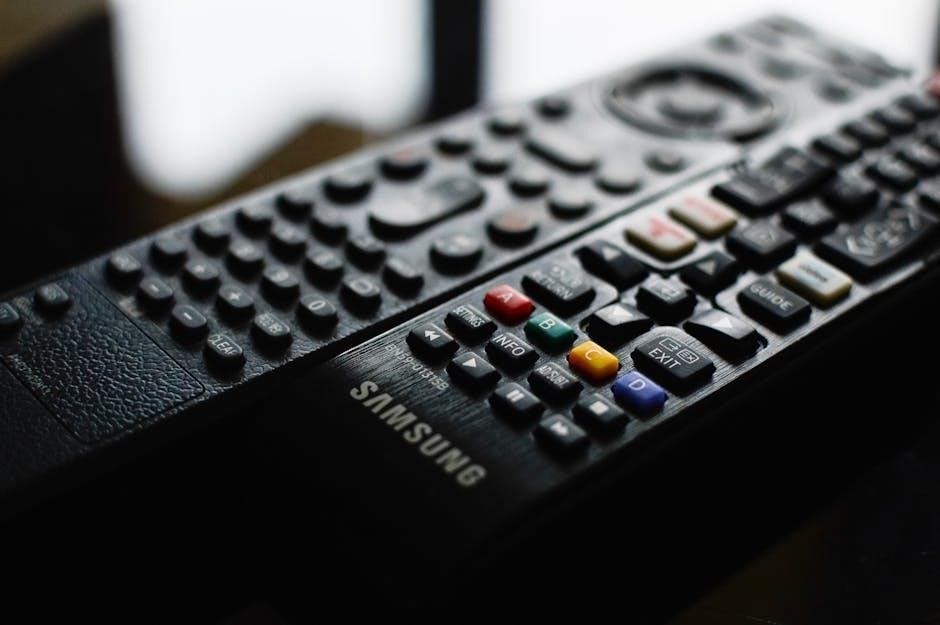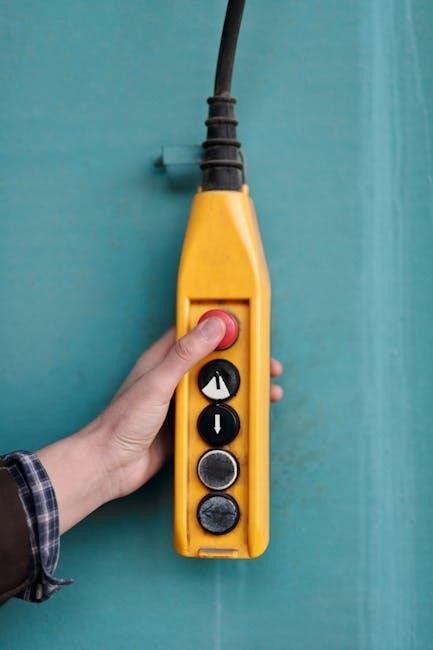
Installation and Setup
Install the remote control by first unpacking and inserting the batteries. Ensure the signal transmitter is properly aligned with the indoor unit; Pair the remote with the air conditioner following the manual’s instructions. Conduct a test operation to verify functionality and address any issues promptly. Store the installation and operation manuals securely for future reference.

1.1. Physical Installation of the Remote Control
Begin by unpacking the remote control and ensuring all components, including the battery compartment and holder, are intact. Insert the provided batteries into the remote, following the polarity guidelines marked inside the compartment. Attach the remote controller holder to a convenient location, such as a wall or table, using the screws provided. Secure the ball chain to the remote and holder to prevent loss. Ensure the remote is positioned in a spot where its infrared signal can reach the indoor unit without obstruction. Avoid placing the remote near water or in humid environments to prevent damage. Finally, test the remote by aiming it at the indoor unit and pressing the power button to confirm proper operation. Keep the remote out of children’s reach to avoid accidental damage or misuse.
1.2. Pairing the Remote Control with the Air Conditioner
Pairing the remote control with the air conditioner ensures seamless communication. First, ensure the air conditioner is powered off. Locate the receiver on the indoor unit, typically found near the display panel. Press and hold the ‘PAIR’ or ‘SYNC’ button on the remote until the LED indicator flashes. Simultaneously, press the ‘PAIR’ button on the indoor unit, usually found on the control panel or behind a small cover. Hold both buttons for approximately 3-5 seconds until the LED stops flashing, indicating successful pairing. If pairing fails, restart the process or consult the manual. Once paired, test the remote by adjusting settings like temperature and mode. Ensure no obstructions block the signal path between the remote and the indoor unit for reliable operation. If issues persist, refer to the troubleshooting section of the manual or contact a technician. Proper pairing ensures optimal performance and convenience.
1.3. Initial Setup and Configuration
After installing and pairing the remote control, proceed with the initial setup. Turn on the air conditioner and familiarize yourself with the remote’s interface. Use the mode button to select operation modes like Cool, Heat, or Fan. Adjust the temperature using the up and down arrows, and set the fan speed for optimal comfort. Review the operation manual to understand advanced features such as timer settings, turbo mode, and sleep mode. Ensure the remote’s signal path to the indoor unit is unobstructed for reliable communication. Test all functions to confirm proper operation. If any issues arise, refer to the troubleshooting section of the manual or contact a professional. Proper setup ensures efficient and customized operation of your Daikin air conditioner, enhancing comfort and energy efficiency. Always store the manual for future reference and updates.

Understanding the Remote Control
The Daikin remote control features essential components like an LCD display, signal transmitter, and buttons for mode selection, temperature adjustment, and fan speed control, ensuring intuitive operation.
2.1. Components of the Daikin Remote Control
The Daikin remote control consists of a signal transmitter, an LCD display, and various function buttons. The transmitter sends commands to the air conditioner, while the LCD provides clear operational feedback. Buttons include power, mode selection, temperature adjustment, fan speed control, and additional features like turbo and quiet modes. The remote also includes a timer function and sleep mode button for energy efficiency. Some models offer advanced features such as wireless LAN connectivity and voice control integration. Properly understanding each component ensures optimal use of the remote control. Regular maintenance, like cleaning the LCD and replacing batteries, is essential for prolonged functionality. The remote’s design prioritizes user convenience and seamless interaction with the air conditioner, making it an indispensable tool for climate control.
2.2. Buttons and Their Functions
The Daikin remote control features an array of buttons designed for intuitive operation. The ON/OFF button powers the air conditioner, while the MODE button cycles through operating modes like Cool, Heat, Fan, and Dry. The TEMPERATURE adjustment buttons allow precise control over the set temperature. The FAN button adjusts airflow speed, and the TURBO button activates faster cooling or heating. The QUIET button reduces operational noise, ideal for nighttime use. The SLEEP button enables energy-saving mode, adjusting temperature settings automatically. The TIMER function allows scheduling of on/off operations. Additional buttons include WIRELESS LAN for smart connectivity and VOICE CONTROL for hands-free operation. The POWERFUL button boosts performance temporarily. The DISPLAY button toggles the LCD screen. Understanding these buttons ensures efficient and personalized climate control, enhancing user experience.
2.3. LCD Display and Indicators
The Daikin remote control features an LCD display that provides clear visual feedback. It shows the current operating mode, set temperature, fan speed, and timer settings. The display also indicates active functions like TURBO, QUIET, and SLEEP modes. LEDs or icons on the display signal operational status, such as when the unit is heating, cooling, or in fan-only mode. Error codes may appear if issues arise, guiding troubleshooting. The display can be toggled on or off using the DISPLAY button, conserving battery life. The LCD’s brightness adjusts automatically or manually, ensuring visibility in various lighting conditions. The indicators help users monitor the air conditioner’s performance and adjust settings efficiently, ensuring optimal comfort and energy efficiency without unnecessary guesswork.

Operating Modes
The Daikin remote control offers multiple operating modes, including Cool, Heat, Fan, and Dry. Each mode is designed for specific climate control needs, ensuring comfort and energy efficiency in various conditions.
3.1. Cool Mode Operation
Cool Mode is designed to lower the room temperature by circulating cool air. To activate, press the Cool button on the remote. Use the temperature adjustment buttons to set your desired temperature. The system will automatically adjust the fan speed and compressor to achieve the set temperature. For faster cooling, enable Turbo Mode, which increases the cooling power temporarily. Ensure no obstacles block the air vents for optimal performance. The LCD display will show the current mode and temperature settings. Adjustments can be made at any time for precise comfort control.
3.2. Heat Mode Operation
Heat Mode provides warmth by circulating heated air throughout the room. Activate it by pressing the Heat button on the remote. Adjust the temperature using the up or down arrows, and the system will maintain the set temperature. For energy efficiency, consider using Sleep Mode, which gradually lowers the temperature during sleep hours. The LCD display confirms the mode and settings. Ensure the outdoor unit is clear of debris for optimal performance. Use the timer function to schedule heating sessions, enhancing convenience and energy savings. Proper operation ensures a comfortable environment while maintaining energy efficiency. Always refer to the manual for detailed instructions or troubleshooting.
3.3. Fan Mode Operation
Fan Mode operates the air conditioner as a fan, circulating air without cooling or heating. Activate it by pressing the FAN button on the remote. Choose from fan speeds: Auto, Low, Medium, or High. The LCD display shows the selected speed. This mode is ideal for ventilation or maintaining air circulation in a room. It does not activate the compressor, making it energy-efficient for light air movement. Use the Turbo button for faster air circulation if needed. Ensure the air filter is clean for optimal performance. Fan Mode is a convenient option for maintaining indoor air quality without temperature changes. Always refer to the manual for specific instructions on fan speed adjustment and operation. Proper use ensures efficient energy consumption and consistent air flow.
3.4. Dry Mode Operation
Dry Mode reduces humidity while maintaining room temperature, preventing overcooling. Activate it by pressing the Dry button on the remote. The air conditioner removes moisture from the air, lowering humidity levels without significant temperature drops. This mode is ideal for humid environments, helping prevent mold growth and musty odors. The fan speed can be adjusted for optimal airflow. Energy consumption is minimized as the compressor runs intermittently. Use this mode to maintain comfort in damp conditions. Ensure proper ventilation for best results. Regularly clean the air filter to enhance efficiency. Dry Mode is a energy-efficient solution for controlling humidity without cooling. Always refer to the manual for detailed instructions on operation and settings. Proper use ensures effective humidity control and improved indoor air quality.

Remote Control Functionality

The remote control offers basic operations like On/Off and temperature adjustment. Advanced features include fan speed settings, mode selection, and energy-saving options like Sleep and Quiet modes. Use the buttons to navigate easily and ensure the remote is pointed directly at the unit for optimal signal transmission. The LCD display provides clear feedback on settings and operational status. Regularly clean the remote to maintain functionality. Always refer to the manual for detailed instructions on using advanced features effectively. Proper use ensures efficient and comfortable operation of your Daikin air conditioner. The remote is designed to enhance user experience with intuitive controls and energy-efficient settings.
4.1. Basic Operations (On/Off, Temperature Adjustment)
Press the ON/OFF button to power the air conditioner. Use the temperature adjustment buttons to increase or decrease the set temperature. The LCD display shows the current settings. Ensure the remote is pointed directly at the indoor unit for proper signal transmission. If the unit does not respond, check for signal obstructions. Clean the remote regularly to maintain functionality. Refer to the manual for detailed instructions on basic operations. Proper use ensures efficient and comfortable operation of your Daikin air conditioner. The remote is designed to enhance user experience with intuitive controls and energy-efficient settings.
4.2. Timer Functions (Setting On/Off Timers)
Use the timer buttons to set on and off times for your air conditioner. Press the TIMER button, then adjust the desired start and stop times using the arrow keys. Confirm your settings with the SET button. The timer ensures energy efficiency by activating the unit only when needed. For recurring schedules, set the timer to repeat daily. If the timer is set to 7:30 AM, the air conditioner will automatically turn on at that time. Ensure the remote has clear signal transmission to the indoor unit. Refer to the manual for advanced timer settings and troubleshooting tips. Proper timer usage enhances convenience and energy savings, making your Daikin air conditioner more efficient and user-friendly. Regularly review and update timer settings to match your lifestyle and preferences for optimal performance.
4.3. Turbo Mode for Faster Cooling/Heating
Activate Turbo Mode using the designated button on your Daikin remote to enjoy faster cooling or heating. This mode increases fan speed to quickly reach your desired temperature, ensuring rapid comfort. It’s ideal for swift temperature adjustments and maintains energy efficiency. Note that Turbo Mode may increase noise levels due to higher fan operation. For optimal performance, ensure the remote control is clean and free from obstructions. Use this feature when you need immediate climate control, such as when entering a hot room. Regular use of Turbo Mode can also help reduce humidity and improve air circulation. Always refer to the manual for detailed instructions on using Turbo Mode effectively and to understand its impact on energy consumption.
4.4. Quiet Operation for Reduced Noise
Activate Quiet Mode using the designated button on your Daikin remote to minimize noise during operation. This feature is ideal for environments where noise reduction is essential, such as bedrooms or home theaters. Press the QUIET button to enable this mode, which lowers the fan speed and reduces operational noise. The air conditioner will continue to maintain the set temperature while operating more quietly. To return to normal operation, press the QUIET button again. Quiet Mode ensures efficient cooling or heating without compromising performance, making it perfect for creating a peaceful environment. For best results, ensure the remote control is aimed directly at the indoor unit and free from signal obstructions. This feature is especially useful during nighttime or in spaces requiring uninterrupted focus.
4.5. Sleep Mode for Energy Efficiency
Sleep Mode is designed to optimize energy consumption while maintaining comfort during nighttime. Activate this mode using the SLEEP button on the remote control. The air conditioner will automatically adjust the temperature settings, slightly raising the set temperature in cooling mode or lowering it in heating mode, to minimize energy usage. This feature ensures a consistent and comfortable environment while reducing operational noise. Sleep Mode is ideal for overnight use, as it balances energy efficiency with uninterrupted comfort. To deactivate Sleep Mode, press the SLEEP button again or adjust the temperature manually. This mode is particularly beneficial for households seeking to lower their energy bills without compromising on comfort. Always refer to the operation manual for specific instructions tailored to your Daikin air conditioner model.

Maintenance and Troubleshooting
Regularly clean the remote control with a soft cloth and avoid exposing it to water. Replace batteries when low and ensure proper signal transmission. Troubleshoot issues by resetting the remote or checking for signal obstructions.
5.1. Cleaning the Remote Control
Regularly clean the remote control to maintain its functionality. Use a soft, dry cloth to wipe the surface, ensuring no moisture enters the device. Avoid using harsh chemicals or abrasive materials that could damage the buttons or display. For stubborn stains, slightly dampen the cloth with water, but avoid excessive moisture to prevent internal damage. Never submerge the remote in water or expose it to direct sunlight. Clean the LCD display gently to avoid scratches. If the remote is equipped with a ball chain, ensure it is securely attached to prevent loss. Store the remote in a dry place when not in use. If signal issues arise, cleaning the remote’s transmitter or checking for obstructions may resolve the problem. Always refer to the manual for specific cleaning instructions tailored to your Daikin remote model.
5.2. Battery Replacement and Maintenance
To ensure optimal performance of the Daikin remote control, regular battery maintenance is essential. Use high-quality alkaline batteries of the correct size, as specified in the manual. Open the battery compartment on the back of the remote by sliding it open or using a screwdriver, depending on the model. Insert the batteries with the correct polarity, ensuring the terminals align properly. Avoid mixing old and new batteries or using rechargeable types, as this may cause signal issues. If the remote’s buttons feel sticky or unresponsive, clean them with a soft cloth. Replace batteries when the LCD display dims or the signal weakens. Store spare batteries in a cool, dry place away from metal objects to prevent drainage. Proper battery maintenance ensures reliable operation and extends the remote’s lifespan.
5.3. Troubleshooting Signal Issues
If the remote control fails to communicate with the air conditioner, check for obstructions like curtains or furniture blocking the signal. Ensure the remote’s transmitter is aimed directly at the indoor unit. Verify that the remote has working batteries and is functioning correctly. If issues persist, turn the air conditioner’s power off, wait a few minutes, and restart it. Check for interference from other electronic devices, such as fluorescent lights or inverters, which can disrupt the signal. If the problem continues, consult the operation manual or contact a certified technician for assistance. Regularly cleaning the remote’s transmitter and the unit’s receiver can also resolve signal issues. Ensure no other remotes or devices are using the same frequency, as this can cause conflicts; Proper troubleshooting ensures smooth operation and maintains the air conditioner’s efficiency.
5.4. Resolving Display Issues
If the remote control’s LCD display is not functioning correctly, start by ensuring the batteries are properly installed and not depleted. A blank or dimmed display may indicate low battery levels. Check for any obstructions blocking the signal between the remote and the indoor unit, as this can cause the display to malfunction. Verify that the remote is aimed directly at the unit’s receiver. If the issue persists, gently clean the remote’s transmitter and the unit’s receiver with a soft cloth to remove dirt or debris. Avoid using harsh chemicals, as they may damage the components. If the display is damaged or cracked, contact a certified technician for repair. Ensure no other electronic devices are interfering with the signal, such as fluorescent lights or inverters. Resetting the air conditioner by turning it off and on again may also resolve the issue. If the problem remains unresolved, refer to the operation manual or contact Daikin support for further assistance.
5.5. Common Faults and Solutions
Common faults with the Daikin remote control include signal issues, display malfunctions, and unresponsive buttons. For signal problems, ensure no obstructions block the line of sight between the remote and the indoor unit. Reset the air conditioner by turning it off and on again. If the display is blank, check the batteries and ensure they are correctly installed. For unresponsive buttons, clean the remote with a soft cloth and avoid using harsh chemicals. If the remote fails to communicate with the unit, verify that it is properly paired. Consult the operation manual for pairing instructions. If issues persist, contact Daikin support or a certified technician for assistance. Regular maintenance, such as cleaning and battery replacement, can prevent many of these faults. Always refer to the manual for specific troubleshooting steps tailored to your model.

Additional Features
The Daikin remote control offers advanced features like wireless LAN connectivity for app-based control and voice integration with smart speakers, enhancing convenience and seamless operation.
6.1; Wireless LAN Connectivity
The Daikin remote control supports wireless LAN connectivity, enabling seamless integration with smart home systems. Users can control their air conditioner via a dedicated app, adjusting settings like temperature, modes, and timers remotely. This feature also allows for voice control through compatible smart speakers, enhancing convenience. The remote’s wireless capabilities ensure smooth communication with the indoor unit, even when obstacles are present. For optimal performance, ensure a stable internet connection and update the remote’s firmware regularly. This feature is compatible with popular smart home platforms, offering a modern and efficient way to manage your air conditioning system. Refer to the manual for detailed setup instructions and troubleshooting tips to ensure a reliable connection.
6.2. Voice Control Integration
Voice control integration allows users to manage their Daikin air conditioner effortlessly using smart speakers. Compatible with Google Assistant and Amazon Alexa, this feature offers enhanced convenience. To set up, link your Daikin account via the dedicated app. Adjust settings like temperature and modes hands-free, benefiting from seamless smart home integration. This feature not only simplifies operations but also ensures compatibility with various smart devices, enhancing your smart home experience. For detailed setup instructions and troubleshooting, refer to the manual provided with your Daikin air conditioner remote control.

Resources and Support
Access official Daikin resources, including operation manuals and troubleshooting guides, on their website or platforms like manualslib.com. Contact customer support for further assistance or queries.
7.1. Downloading the Operation Manual
To download the operation manual for your Daikin air conditioner remote control, visit Daikin’s official website or trusted platforms like manualslib.com. Search for your specific model, such as the Daikin ARC452A4 or BRC1C61, to access the corresponding manual. Ensure the manual matches your remote control model for accurate guidance. These manuals provide detailed instructions on remote control functionality, troubleshooting, and maintenance. You can also find operation manuals for models like FTXS25-35J2VMA and GS02. Download the PDF files directly from these sites to ensure authenticity and reliability. Refer to the manual for step-by-step instructions on using your remote control effectively. For additional support, Daikin offers resources like animated operation guides and user reference manuals. Always verify the source to avoid unauthorized or outdated documents.
7.3. Online Forums and Communities
For additional support and guidance, visit online forums and communities dedicated to Daikin air conditioner remote control discussions. Platforms like Daikin’s official support center and independent forums offer valuable resources, including troubleshooting tips, user experiences, and detailed explanations. These communities often include threads on specific models, such as the Daikin ARC452A4 or BRC1C61, where users share their insights and solutions. You can also find discussions about remote control functionality, maintenance, and advanced features like wireless LAN connectivity. Engage with other users to resolve common issues or learn how to optimize your remote control’s performance. Additionally, Daikin’s official website provides access to a wealth of information, including operation manuals and FAQs. These forums are a great resource for understanding your remote control better and addressing any challenges you may encounter.